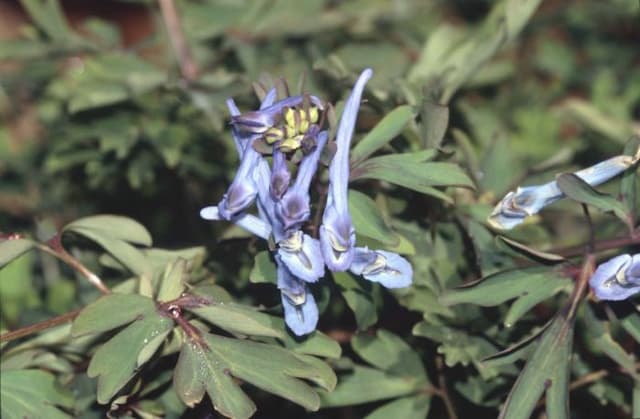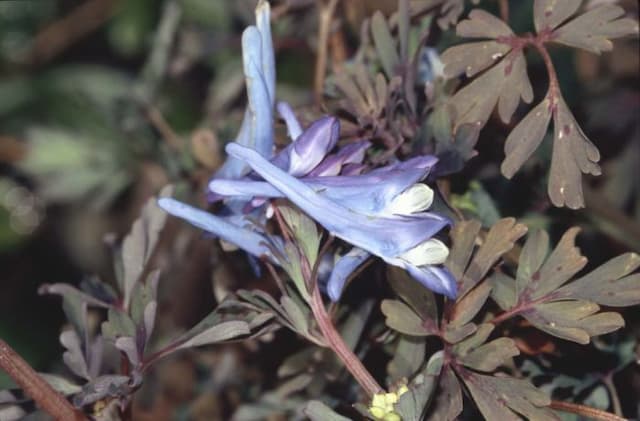Climbing squirrel corn Dactylicapnos torulosa

ABOUT
D. torulosa is an annual climber with finely divided foliage and hanging clusters of yellow, locket-shaped flowers. Grown mostly for its striking seed pods, to 15cm, terracotta red and beaded, which open to show black and white seeds
About this plant
 Names
NamesFamily
Papaveraceae
Synonyms
Himalayan Chain-flowered Climber
Common names
Dactylicapnos torulosa.
 Characteristics
CharacteristicsLife cycle
Annuals
Foliage type
Deciduous
Color of leaves
Green
Flower color
Yellow
Height
10 feet (3 meters)
Spread
3 feet (1 meter)
Plant type
Climber
Hardiness zones
8
Native area
Himalayas
Benefits
 General Benefits
General Benefits- Landscape Enhancement: Dactylicapnos torulosa, commonly known as Himalayan chain vine, adds aesthetic value to gardens with its lush foliage and attractive, pendant yellow flowers.
- Pollinator Attraction: The plant's flowers attract bees and butterflies, which are essential pollinators for many ecosystems and gardens.
- Erosion Control: The Himalayan chain vine can be used on slopes and banks to help stabilize soil and prevent erosion due to its climbing habit.
- Vertical Gardening: It is ideal for vertical gardening as it can climb trellises and walls, allowing gardeners with limited horizontal space to cultivate an attractive green environment.
- Shade Provision: When grown over pergolas or along arbors, the vine creates natural shaded areas, which can be beneficial in creating cool, comfortable outdoor spaces during warm weather.
- Privacy Screen: With its dense growth, it can serve as a living privacy screen, obscuring unwanted views and reducing noise pollution.
- Wildlife Habitat: The dense foliage can provide shelter and nesting sites for certain bird species, enhancing local biodiversity.
- Seasonal Interest: The vine’s seasonal changes in foliage and flowering offer visual interest throughout its growing season, contributing to a dynamic garden experience.
- Cultural Significance: In some cultures, the plant may have symbolic significance or be used in traditional ornamental gardening practices.
- Recreational Use: Gardeners may find cultivation and care for the Himalayan chain vine to be a fulfilling and enjoyable hobby.
 Medical Properties
Medical PropertiesThis plant is not used for medical purposes.
 Air-purifying Qualities
Air-purifying QualitiesThis plant is not specifically known for air purifying qualities.
 Other Uses
Other Uses- Dactylicapnos torulosa, commonly known as Climbing Bleeding Heart, can be used in landscape design for its ornamental flowers, adding a touch of whimsy to arbors or trellises.
- The Climbing Bleeding Heart's foliage can add a lush green backdrop in floral arrangements when cut and included with other flowers.
- Due to its climbing habit, it can be used as a natural screen to provide privacy in gardens or on balconies.
- The plant can be included in butterfly gardens, as its flowers may attract pollinators and contribute to local biodiversity.
- You can use the seeds of Climbing Bleeding Heart as a teaching tool to illustrate seed dispersal mechanisms to students studying botany.
- The twining stems of the plant can be creatively used in crafts or as a natural tie for staking other plants in the garden.
- Its dried seed pods can be used in dry flower arrangements or as part of decorative wreaths due to their unique shape and texture.
- Climbing Bleeding Heart can be cultivated as a cover for unsightly garden elements like compost bins or rain barrels, helping to integrate them into the landscape more gracefully.
- The seasonal growth cycle of Climbing Bleeding Heart provides a natural indicator of the changing seasons, ideal for use in a phenological garden that tracks yearly plant cycles.
- In photography, the distinctive heart-shaped flowers of the plant can serve as an enchanting subject for macro and close-up photography experiments.
Interesting Facts
 Feng Shui
Feng ShuiThe Dactylicapnos torulosa, commonly known as Himalayan Goldthread, is not used in Feng Shui practice.
 Zodiac Sign Compitability
Zodiac Sign CompitabilityThe Himalayan Goldthread is not used in astrology practice.
 Plant Symbolism
Plant Symbolism- Connection: Dactylicapnos torulosa, commonly known as "Climbing Bleeding Heart," features heart-shaped flowers, which often symbolize love and connection. In the context of this plant, the climbing nature might also suggest a striving for higher connection or reaching out to bond with others.
- Persistence: As a climbing plant, the Climbing Bleeding Heart is often seen as a symbol of determination and the ability to persevere, as it continuously grows and reaches upwards, overcoming obstacles in its path.
- Elegance: The delicate appearance of its flowers often leads to its association with grace and elegance, making it a symbol of beauty in the face of adversity.
- Compassion: The "bleeding" aspect of its common name might imply a sense of empathy or compassion, symbolizing a heart that feels deeply for others.
 Water
WaterThe Climbing Bleeding Heart should be watered regularly to keep the soil consistently moist but not soggy. During the growing season, it might require watering once or twice a week with about 16 to 32 ounces each time, depending on the local climate and weather conditions. Reduce the frequency of watering during the dormant winter months. It's important to avoid over-watering, which can lead to root rot.
 Light
LightClimbing Bleeding Heart thrives in partial shade to full sun. The best spot is one where the plant can receive morning sun and is protected from the harsh afternoon sun. Ensure that it has access to bright, indirect light for the majority of the day.
 Temperature
TemperatureClimbing Bleeding Heart prefers temperate conditions and thrives in a temperature range of 50°F to 77°F. It can tolerate minimum temperatures down to 32°F but should be protected from frost. Avoid exposing it to temperatures above 86°F to prevent heat stress.
 Pruning
PruningPrune Climbing Bleeding Heart to maintain its shape and remove any dead or damaged growth. Pruning is best done in late winter or early spring before the plant starts its new growth. It doesn't require frequent pruning; once a year should suffice.
 Cleaning
CleaningAs needed
 Soil
SoilHimalayan Chain Fern requires well-draining soil with rich organic matter. A mix of loam, peat, and sand in equal parts is ideal, ensuring good drainage and aeration. The soil pH should be slightly acidic to neutral, ranging from 6.0 to 7.0 for optimal growth.
 Repotting
RepottingHimalayan Chain Fern should be repotted every 2-3 years or when it outgrows its current pot. Refreshing the soil and pot size allows the plant to continue growing healthily.
 Humidity & Misting
Humidity & MistingHimalayan Chain Fern thrives in high humidity conditions. Maintaining a humidity level around 60-80% is ideal for this plant's growth, mimicking its native moist and humid habitats.
 Suitable locations
Suitable locationsIndoor
Place in bright, indirect light and maintain high humidity.
Outdoor
Plant in shady spot, protect from direct sun and frost.
Hardiness zone
8-10 USDA
 Life cycle
Life cycleDicentra torulosa, also known as Dactylicapnos torulosa or Chain Fern Bleeding Heart, begins its life cycle as a seed that requires a period of cold stratification to break dormancy before germination can occur. Once germinated, a seedling emerges and develops into a young plant with characteristic fern-like foliage. As it matures, the plant forms a climbing vine that seeks support from nearby structures or plants to gain sunlight. During its flowering stage, typically in the summer months, it produces pendulous, yellow heart-shaped flowers that hang in chains, attracting pollinators such as bees. After pollination, the flowers develop into elongated capsules containing numerous seeds, which, when mature, disperse to begin the cycle anew. The plant is a perennial, so it dies back to its root system in winter, to regrow the following spring.
 Propogation
PropogationPropogation time
Spring to Summer
Dactylicapnos torulosa, commonly known as Himalayan Goldthread, is typically propagated from seed. The most popular method of propagation begins with seed collection, which should occur when the seed capsules have dried on the plant, usually in late summer or fall. After collecting, the seeds may need stratification, a process of simulating natural winter conditions by placing the seeds in moist sand or a paper towel, sealing them in a plastic bag, and refrigerating for a period, often 3-6 weeks. After stratification, the seeds should be sown in a well-draining soil mix, covered lightly with soil, and kept at room temperature with consistent moisture. Germination can be slow and erratic, so patience is required. Seedlings typically appear in spring, and once they're large enough to handle, they can be potted on into individual containers.









